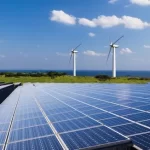What’s does humanity output more than anything else? Garbage…about 5 billion tons of it a year. When you consider that the planet’s population is close to 7 billion, that means each of us is responsible for producing more than 3/4 of a ton of trash each year.
What do we do with the garbage we produce? In North America, for the most part, we bury it in landfill sites. In parts of the developing world open garbage pits are scavenging sites for the poorest of humanity seeking to eke out enough to feed themselves and their families. In some areas of our planet, however, we are learning to treat garbage and waste as a resource.
Here are two examples.
- Denmark is heavily invested in waste-to-heat technology. Garbage is incinerated in “near-zero emission” plants and the heat generated is used to generate electricity and even directly warm nearby homes and buildings. Denmark’s 29 waste-to-electricity plants are outfitted with filters to catch CO2, mercury, dioxin, and other pollutants. Denmark’s existing plants serve 98 municipalities. 10 more facilities are planned or under construction. Denmark isn’t alone in Europe in mining garbage to generate energy. There are approximately 400 incinerators being used this way across the continent with Germany and the Netherlands joining Denmark as technology leaders.
- Waste Management, the $12.5 billion U.S. conglomerate, collects landfill gas as an energy resource. The company mines its 129 landfill sites collecting methane gas and using it to fuel its truck fleets. The company also operates a number of waste-to-energy incinerators generating enough energy to light up over 1 million homes.
The Environmental Challenges to Waste as an Energy Source
There are two:
- Plant emissions can never truly be zero. The byproducts of the burning process are in themselves garbage and have to be dealt with.
- Those things that burn best are usually recyclable and can be used in manufacturing with minimal environmental impact.
Zero-Emission Incineration is not Zero
Environmentalists are absolutely correct when they point to the emissions potential of waste-to-energy incineration technology. Pollutant emissions can be highly variable depending on the garbage being burned. In sampling incinerator output you can find lead, cadmium, arsenic, chromium, mercury, and many different hydrocarbons and organic compounds such as dioxin and furans. Newly developed filters and scrubbers capture many of these emissions. Recorded reductions in heavy metals and toxic chemicals on Danish waste-to-energy incinerators are well below the thresholds set by environmental agencies. Most recent studies in Denmark show 10 to 20 percent of toxic substance levels allowed by the European Union.
Opponents of incineration argue that incineration does not eliminate garbage. Incinerators merely turn the garbage into something new that is much harder to deal with — toxic sludge. By volume, the reduction from raw waste to sludge leaves a residue about 45% according to some studies. And these toxic materials have to go into some form of landfill. In the case of Danish waste-to-energy incinerators, toxic residue is securely stored in warehouses that are environmentally secure. In Germany toxic sludge is buried inside mine shafts where it is securely contained to make sure that it cannot enter the surrounding rock and eventually contaminate groundwater sources.
The final byproduct of waste-to-energy plants is ash residue. Ash residue varies in composition based on what is burned. In a typical incinerator the residue consists of a mix of ceramics, slag, glass and ferrous metals. Not all material gets consumed during incineration. Approximately 15% of the total volume of residue remains unaltered with the balance being ash. Typical composition of incinerator ash is:
- Opaque glass 25%
- Isotropic glass 20%
- Melite group minerals (aluminium-based and organic residue) 20%
- Schlieren 10% (variable composite minerals)
- Magnetite & Chromite minerals 10%
It is difficult to know how stable any of the residual chemicals are within incinerator ash.This makes using the ash as a component in manufacturing somewhat problematic. Materials made from ash residue exhibit many of the same characteristics as volcanic rock. They wear easily and when exposed to weather and liquid can breakdown and become unstable. As a result material application of incinerator residue is limited to very basic construction materials such as road bedding. Even then liners are often applied to make sure that residual chemical leaching doesn’t percolate into the surrounding aquifer compromising groundwater sources.
Typically the ash from garbage incinerators is not used in brick, concrete and other building materials where it can be a potential environmental risk.
Zero-Waste Recycling
Even in Denmark, burning garbage is not the preferred method of dealing with the waste. Recyclables when compared to incinerated waste represent a ratio of 2:1 in some Danish cities. What recycling means to incineration is this – by removing those waste items that can be reused, incinerators are left to burn items that often don’t burn very well.
Looking at a typical residential recycling bin, by volume, the most common item is paper followed by plastic. Both of these recyclables have very high combustability. They also are large CO2 producers. So taking them out of the incinerator stream means less CO2 to trap as part of the process.
Food waste is also removed from garbage and composted. Food waste is fairly combustible but given a choice between burning and composting the latter is favoured over the former.
Is it Worth it to Burn Garbage?
There are many issues involved in using garbage this way. Some of these issues concern where you are from as much as what impact the burning has on the environment.
Garbage burns and it is renewable because every one of us contributes to it daily. We can reduce, reuse and recycle to ease the volume but we cannot zero it out so that we leave none of it to clutter the landscape or become landfill. Just like we cannot ensure that if we burn it we can eliminate all emissions and reduce the byproducts of the burn to inert substances or reusable materials.
The question then is can we get enough energy from garbage to warrant making the investment that countries like Denmark, Holland and Germany are currently making? One of the reasons European countries started down the path of burning garbage was the decreasing amount of space for landfill because Europe has a big population with a lot less land than the U.S.
The Case for the U.S.
Today in the U.S. where there is lots of room for landfill, very little energy is derived from waste-to-energy incineration. But there is a growing interest in garbage as a renewable resource for energy generation. This interest is driven by a desire to become less dependent on foreign-imported oil. In its most recent reports the U.S. Department of Energy indicates the potential to generate 15 Gigawatts of energy from municipal waste burned in incinerators. That represents a tiny percentage of the total energy requirements of the country. The statistics don’t include energy generated from methane siphoned from landfill but that number is less than 3 Gigawatts capacity. So the total energy derived from garbage as a resource amounts to less than 4% of the total energy capacity within the U.S.
The Case for India
For countries with fewer alternate energy resources garbage may prove to be too readily attractive to ignore. A good case example is India. India’s economy is growing rapidly. So is its population. Most of that population is settling in urban areas like the City of Mumbai. Municipal waste is a growing problem as a result. For these reasons India is looking at the potential benefit of waste-to-energy.
Today urban landfill is largely unmanaged in India with large areas of the landscape covered by garbage. In a 2009-10 report, India estimated it produced 55 million tonnes of municipal waste annually and that the rate of growth was approximately 1-1.33% annually. Incineration, therefore, is seen as one way of eliminating waste while freeing up scarce land currently used for landfill. At the same time incineration can help India meet its energy demands as it continues to move away from a largely agrarian economy to one of manufacturing and services.
The above cases illustrate very different drivers compelling countries to look at waste-to-energy technologies. As our global population continues to grow towards a peak of 9 billion by mid-century, the pressure to use garbage as an energy source will not diminish. The evolution of the technology to minimize the environmental impact will make incineration look more and more attractive. Landfill sites will sprout incinerators as they are mined for their energy potential.














